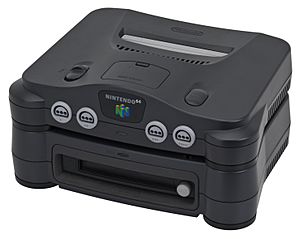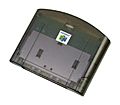Nintendo 64DD facts for kids

A Nintendo 64, with the 64DD installed.
|
|
| Developer | Nintendo, Alps Electric |
|---|---|
| Manufacturer | Alps Electric |
| Type | Video game console peripheral |
| Generation | Fifth generation (32-bit/64-bit era) |
| Release date |
|
| Retail availability | 1999–2001 |
| Discontinued |
|
| Units shipped | 15,000 (estimated) |
| Media | Magnetic disk (64 MB) |
| Storage | 36 megabit ROM (audio/font) |
| Input | Microphone |
| Camera | Game Boy Camera |
| Connectivity | 28.8 kbps dialup modem |
| Online services | Randnet |
| Dimensions | 10.2" x 7.5" x 3.1" (260mm x 190mm x 78.7mm) |
| Weight | 3.53 lbs (1.6kg) |
| Related articles | Nintendo 64 |
The Nintendo 64DD (DD stands for Disk Drive) was a special add-on for the Nintendo 64 game console. It was designed to use magnetic disks, which could hold more data than the regular Nintendo 64 game cartridges. It came out in Japan in 1999. However, it wasn't very successful because it was released quite late in the life of the Nintendo 64. Other new consoles, like the Sega Dreamcast and later the Nintendo GameCube (which used CDs), were already available or coming soon. Because of this, only a few games were ever made for the 64DD, and it was stopped in 2001. The console was released only in Japan.
Contents
What Was the Nintendo 64DD?
The Nintendo 64DD was a unique accessory that attached to the bottom of the Nintendo 64 console. It allowed the Nintendo 64 to use special 64 MB magnetic disks. These disks could store more information than the game cartridges used by the Nintendo 64. This meant games could be bigger and more complex. The 64DD also allowed for new features like a built-in clock and the ability to connect to the internet.
Why It Didn't Do Well
The Nintendo 64DD faced many challenges, which led to it not being very popular.
Late Release Date
The biggest problem was that it came out very late. By the time it launched in Japan in December 1999, the Nintendo 64 console was already a few years old. Gamers were starting to look forward to the next generation of consoles.
Strong Competition
Another reason for its struggles was the strong competition. The Sega Dreamcast had already been released and was quite popular. Soon after, Nintendo itself was developing the Nintendo GameCube. The GameCube used CDs for its games, which were becoming the standard for new consoles. This made the 64DD's disk format seem less advanced.
Few Games Released
Because it wasn't very popular, not many games were made for the 64DD. This created a cycle where fewer games meant fewer people bought the system, and fewer systems sold meant less reason to make games.
Games and Cancellations
Many exciting games were planned for the Nintendo 64DD, but most of them were never released.
Planned Games
One of the most anticipated games was Super Mario 64 2. This was meant to be a direct sequel to the hugely popular Super Mario 64. However, it was cancelled along with many other projects. Instead, an improved version called Super Mario 64 DS was released in 2004 for the Nintendo DS. This remake had more characters, more stars to collect, and better graphics.
Released Games
Only a small number of games actually came out for the 64DD. All four of the Mario games released for the system were part of the Mario Artist series. These games were more about creativity and art than traditional platforming adventures.
Images for kids
See also
 In Spanish: Nintendo 64DD para niños
In Spanish: Nintendo 64DD para niños







